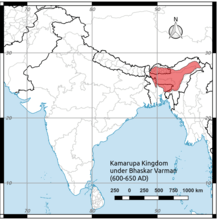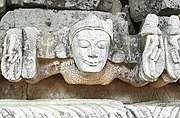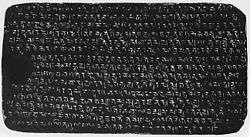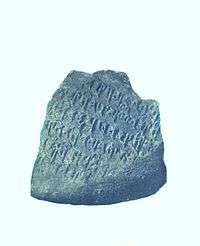Bhaskaravarman
Bhaskaravarman (bʱaːskərə'vərmən) (600–650), the last of the Varman dynasty, was perhaps the most illustrious of the kings of the medieval Kamarupa. After being captured by the Gauda king during the reign of his father, he was able to re-establish the rule of the Varman's. He made political alliances with Harshavardhana of Thaneswar, against the alliance of the Gauda and East Malwa.[1] He was visited by Xuanzang and Li Yi-piao, the envoy of the Tang dynasty who have left accounts of the king and the kingdom.
| Bhaskaravarman | |
|---|---|
 The Kamarupa kingdom of Bhaskaravarman |
| Part of a series on the | ||||||||||||||||||||||||||||
| History of Kamarupa | ||||||||||||||||||||||||||||
|---|---|---|---|---|---|---|---|---|---|---|---|---|---|---|---|---|---|---|---|---|---|---|---|---|---|---|---|---|
 | ||||||||||||||||||||||||||||
| Ruling dynasties | ||||||||||||||||||||||||||||
|
Varman dynasty (350–650 CE)
|
||||||||||||||||||||||||||||
|
Mlechchha dynasty (650–900 CE)
|
||||||||||||||||||||||||||||
|
Pala Dynasty (900–1100 CE)
|
||||||||||||||||||||||||||||
| Part of a series on the |
| History of Assam |
|---|
 |
|
Proto-historic |
|
Late Medieval |
|
Modern |
|
Contemporary |
| Categories |
|
Bhaskaravarman came to power after his brother Supratisthitavarman had died. He was the first Kamarupa king to claim descent from the mythical Narakasura, Bhagadatta and Vajradatta.[2] After his death Salasthambha, who established the Mlechchha dynasty, acquired power in Kamarupa Kingdom.
He issued the Dubi and Nidhanpur copper plate grants, re-issued after his ancestor Bhutivarman, and a clay seal found in Nalanda.
Background
After Susthitavarman was defeated by Mahasenagupta, his son Supratisthitavarman came to power, who built Kamarupa's elephant army but died prematurely without an heir. Thus, the younger son, Bhaskaravarman, came to power in Kamarupa.[3] Even after he succeeded to the throne c. 600 CE, Bhaskaravarman was known as kumara (prince), probably because he was a bachelor throughout his life.[4]
Rivals
Mahasenagupta, in alliance with Shashanka, had defeated on Susthitavarman and took control over north and central Bengal. After the death of Mahasenagupta Shashanka became the ruler of this portion.[5] On ascending the throne Bhaskaravarman found two strong rival powers growing in northern India, viz. one in central and northern Bengal under Shashanka and the other in mid-India under Prabhakaravardhana, the father of Harshavardhana.[4]
When Shashanka murdered Rajyavardhana who had succeeded Prabhakaravardhana as the king at Thaneswar, Bhaskaravarman sent an envoy, Hangsavega, to form an alliance. This incident by both Bana and Xuanzang.[6]
Alliance with Harsha
The Harsha Charita of Bana gives a detailed account of Hangsavega's meeting with Harsha. Plying him with gifts and praise, the diplomat was able to effect an offensive and defensive alliance between the two kings.
The Nidhanpur copper-plate grant was issued from Bhaskaravarman's victorious camp at Karnasuvarna,[7] the erstwhile capital of Shashanka.
Alliance with Chinese
After 648 CE, the Chinese invaded India to avenge the insult done to Chinese representatives at the court of Harshavardhana by the minister who usurped the throne of Harshavardhana after his death. The minister was defeated and captured. In the conflict, Bhaskaravarman aided the Chinese with supplies of cattle, horse and accoutrement.[8]
Xuanzang's account
The Chinese traveller, Xuanzang, visited Bhaskaravarman in his court on his invitation, noting the King patronised Buddhism though a non-Buddhist.[9] According to the text of the Si-yu-ki, the circumference of the capital of Kamarupa was thirty li and the king who was Bhaskaravarman, a Brahman by caste. Xuanzang translated into sanskrit the Taoist text, Daodejing at the request of Bhaskar Varman[10]
Kamarupa of Bhaskaravarman
Xuanzang, in his travelogue, noted that he crossed a great river Karatoya before entering the Kamarupa. The eastern boundary was a line of hills close to the Chinese frontier. He also said Kamarupa was nearly 1700 miles in circumference. The climate was genial. He mentioned that the people were are short height and of yellow complexion and Bhaskar Varman was Hindu and not Buddhist. The people were honest. Their speech differed a little from that of mid-India. They were of violent disposition but were persevering students. They worshipped the Devas and did not believe in Buddhism. The Deva-temples were some hundreds in number and the various systems had some myriads of professed adherents. The few Buddhists in the country performed their acts of devotion in secret. The pilgrim ascertained from the people that to the east of the country was a series of hills which reached as far as the confines of China. The inhabitants of these hills were akin to the "Man of the Lao". In the south-east of the country elephants were plentiful.[11]
Description
Xuanzang notes that Kamarupa was low and moist, and that the crops were regular. Cocoa-nuts and jackfruits grew abundantly and were appreciated by the people. The description provided is around the present-day Guwahati.
According to the account given in the Si-yu-ki, the circumference of Kamarupa was about 1,700 miles (2,700 km). As Edward Albert Gait has pointed out, this circumference must have included the whole of the Assam valley, Surma valley, parts of North Bengal, and parts of Mymensingh.
Religion
Bhaskaravarman was a worshiper of Shiva, though he had great reverence for learned Buddhist priests and professors of his time, and was distinctly inclined towards Buddhism. The general populace worshiped the Devas worshiped in many temples, and adherents of Buddhism practised devotion secretly.
Culture
According to Xuanzang, the people of Kamarupa were honest, albeit with a violent disposition, but were persevering students. The people were are short in height and of yellow complexion. Their speech differed from that of mid-India. The Nidhanpur grant issued from Karnasuvarna, contained local literary forms and offices not found in subsequent Kamarupa inscriptions
Art and industry
The gifts from Bhaskaravarman to Harshavardhana contained mostly products of the land—royal umbrella of exquisite workmanship studded with valuable gems, puthis written on Sachi-bark, dyed cane-mats, Agar-essence, musk in silk-bags, liquid molasses in earthen-pots, utensils, paintings, a pair of Brahmini ducks in a cage made of cane and overlaid with gold, and a considerable quantity of silk-fabrics indicating industry was rudimentary.
Nidhanpur inscription

Bhaskaravarman praises himself in his Nidhanpur copper-plate inscription, saying that "he has revealed the light of the Arya religion by dispelling the accumulated darkness of Kali age, by making a judicious application of his revenues; who has equalled the prowess of the whole ring of his feudatories by the strength of his own arm, who has derived many a way of enjoyment for his hereditary subjects whose loyal devotion to him was augmented by his steadiness, modesty and affability, who is adorned with a wonderful ornament of splendid fame made of the flowery words of praise variously composed by hundreds of kings vanquished by him in battle; whose virtuous activities, like those of Sivi, were applied in making gifts for the benefit of others; whose powers, as of a second preceptor of the Gods (Brihaspati), was recognised by others on account of his skill in devising and applying the means of politics that appear in suitable moments; whose own conduct was adorned by learning, valour, patience, prowess and good actions".[12]
Nalanda seal

Bhaskaravarman's close connection with Harsha and Xuanzang led to his association with the famous Buddhist university of Magadha, for his seal has been discovered at the site of Nalanda in the company of two fragmentary seals of Harsha. The seals were found by Dr. Spooner during the excavation of the ruins of Nalanda in the year 1917–18. The text of the seal is as follows:[13]
Sri Ganapati Varma Sri Yajnavatyam Sri Mahendra Varma.
Sri Suvratayam Sri Narayanavarma Sri Devavatyam Sri Mahabhuta Varma.
Sri Vijnana Vatyam Sri Chandramukha Varma Sri Bhogavatyam.
Sri Sthitavarma tena Sri Nayana Sobhayam (Sri Susthitavarma)
(Sri Syama Lakshmyam) Sri Supratisthita Varma.
Sri Bhaskara Varmeti.
K.N. Dikshit, in his "Epigraphical notes of the Nalanda finds", thinks that the seal probably accompanied Bhaskaravarman's letter to Silabhadra inviting Xuanzang.[14] As however it was found in the company of the two Harsha seals the probability is that both Harsha and Bhaskaravarman, on their march from Rajmahal to Kanauj, visited Nalanda together with the Chinese pilgrim and, to commemorate their visit, left their respective seals at the university.[15]
Death
It is not known how or when Bhaskaravarman died, but it is estimated that his reigned ended about 650.
Legacy
Kumar Bhaskar Varma Sanskrit and Ancient Studies University of Nalbari, Assam has been named after him.
See also
Notes
- Sen, Sailendra (2013). A Textbook of Medieval Indian History. Primus Books. p. 39. ISBN 978-9-38060-734-4.
- "The mythical ancestors of (the Varman) line of rulers were Naraka, Bhagadatta and Vajradatta." (Sharma 1978:0.29)
- Kamarupa Sasanavali. p. 31.
- Barua 1933, p. 58.
- Banger Jatiya Itihas, Rajanya Kanda.
- Barua 1933, p. 62.
- Epigraphia Indica Vol XII. p. 78.
- Chatterji, Suniti Kumar (1951). Kirata-jana-krti. pp. 90, 92.
- (Gait 1906:53–55)
- Chung, Tan (December 1998). Across the Himalayan Gap: An Indian Quest for Understanding China. Gyan Publishing House. ISBN 978-81-212-0617-4.
- (Gait 1926:23–24)
- Epigraphia Indica Vol XII. p. 78.
- J.B.O.R.S Vol VI. p. 151.
- ibid.
- Barua 1933, p. 98.
References
- Barua, Kanak Lal (1933). Early History Of Kamarupa.CS1 maint: ref=harv (link)
- Gait, E A (1906), A History of Assam, Thacker, Spink and Co., Calcutta
- Gait, Sir Edward (1926), A History of Assam, Lawyer's Book Stall, Guwahati
- Ghosh, Suchandra (2012). "Karnasuvarna". In Islam, Sirajul; Jamal, Ahmed A. (eds.). Banglapedia: National Encyclopedia of Bangladesh (Second ed.). Asiatic Society of Bangladesh.
- Kāmarūpa-Kaliṅga-Mithilā:a politico-cultural alignment in Eastern India : history, art, traditions by Chandra Dhar Tripathi, Indian Institute of Advanced Study
- Sharma, Mukunda Madhava (1978). Inscriptions of Ancient Assam. Gauhati University, Assam.
| Wikimedia Commons has media related to Bhaskaravarman. |